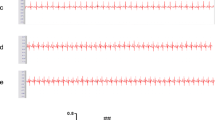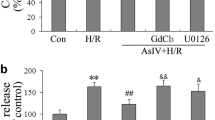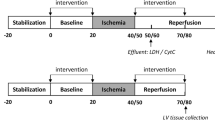Abstract
Purpose
To evaluate whether aleglitazar (Ale), a dual PPARα/γ agonist, has additive effects on myocardial protection against ischemia-reperfusion injury.
Methods
Human cardiomyocytes (HCMs), cardiomyocytes from cardiac-specific PPARγ knockout (MCM-PPARγCKO) or wild type (MCM-WT) mice were incubated with different concentrations of Ale, and subjected to simulated ischemia-reperfusion (SIR) or normoxic conditions (NSIR). Cell viability, apoptosis and caspase-3 activity were determined. HCMs were transfected with siRNA against PPARα (siPPARα) or PPARγ (siPPARγ) followed by incubation with Ale. PPARα/γ DNA binding capacity was measured. Cell viability, apoptosis and levels of P-AKT and P-eNOS were assessed. Infarct size following 30 min coronary artery occlusion and 24 h reperfusion were assessed in WT and db/db diabetic mice following 3-day pretreatment with vehicle, Ale or glimeperide.
Results
Ale (at concentrations of 150–600 nM) increased cell viability and reduced apoptosis in HCMs, MCM-WT and MCM-PPARCKO exposed to SIR. In HCM, the protective effect was partially blocked by siPPARα alone or siPPARγ alone, and completely blocked by siPPARα+siPPARγ. Ale increased P-Akt/P-eNOS in HCMs. P-Akt or P-eNOS levels were decreased when PPARα alone, PPARγ alone and especially when both were knocked down. Peritoneal GTTs revealed that db/db mice had developed impaired glucose tolerance and insulin sensitivity, which were normalized by Ale or glimepiride treatment. Ale, but not glimepiride, limited infarct size in both WT and diabetic mice after ischemia-reperfusion.
Conclusions
Ale protects against myocardial apoptosis caused by hypoxia-reoxygenation in vitro and reduces infarct size in vivo.







Similar content being viewed by others

Abbreviations
- Ale:
-
Aleglitazar
- Glim:
-
Glimeperide
- GTT:
-
Glucose tolerance test
- HCMs:
-
Human cardiomyocytes
- mCM-WT:
-
Cardiomyocytes from wild type
- LDH:
-
Lactate dehydrogenase
- MTT:
-
Thiazolyl blue tetrazolium bromide
- NSIR:
-
No simulated ischemia reperfusion
- PPARα:
-
Proliferator-activated receptor-α
- PPARγ:
-
Peroxisome proliferator-activated receptor- γ
- PPARγ CKO:
-
Cardiomyocytes from cardiac-specific PPARγ knockout mice
- SDS:
-
Sodium Dodecyl sulfate
- siPPARα:
-
siRNA against PPARα
- siPPARγ:
-
siRNA against PPARγ
- SIR:
-
Simulated ischemia reperfusion
- T2DM:
-
Type 2 diabetes mellitus.
References
Hansen BC, Tigno XT, Benardeau A, et al. Effects of aleglitazar, a balanced dual peroxisome proliferator-activated receptor alpha/gamma agonist on glycemic and lipid parameters in a primate model of the metabolic syndrome. Cardiovasc Diabetol. 2011;10:7.
Lehto S, Pyorala K, Miettinen H, et al. Myocardial infarct size and mortality in patients with non-insulin-dependent diabetes mellitus. J Intern Med. 1994;236:291–7.
Deedwania P, Kosiborod M, Barrett E, et al. Hyperglycemia and acute coronary syndrome: a scientific statement from the American Heart Association Diabetes Committee of the Council on Nutrition, Physical Activity, and Metabolism. Circulation. 2008;117:1610–9.
Haffner SM, Lehto S, Ronnemaa T, et al. Mortality from coronary heart disease in subjects with type 2 diabetes and in nondiabetic subjects with and without prior myocardial infarction. N Engl J Med. 1998;339:229–34.
Mukamal KJ, Nesto RW, Cohen MC, et al. Impact of diabetes on long-term survival after acute myocardial infarction: comparability of risk with prior myocardial infarction. Diabetes Care. 2001;24:1422–7.
Stranders I, Diamant M, van Gelder RE, et al. Admission blood glucose level as risk indicator of death after myocardial infarction in patients with and without diabetes mellitus. Arch Intern Med. 2004;164:982–8.
Birnbaum Y, Long B, Qian J, et al. Pioglitazone limits myocardial infarct size, activates Akt, and upregulates cPLA2 and COX-2 in a PPAR-gamma-independent manner. Basic Res Cardiol. 2011;106:431–46.
Ye Y, Hu Z, Lin Y, et al. Downregulation of microRNA-29 by antisense inhibitors and a PPAR-gamma agonist protects against myocardial ischaemia-reperfusion injury. Cardiovasc Res. 2010;87:535–44.
Ye Y, Lin Y, Manickavasagam S, et al. Pioglitazone protects the myocardium against ischemia-reperfusion injury in eNOS and iNOS knockout mice. Am J Physiol Heart Circ Physiol. 2008;295:H2436–46.
Makino N, Maeda T, Oyama J, et al. Improving insulin sensitivity via activation of PPAR-gamma increases telomerase activity in the heart of OLETF rats. Am J Physiol Heart Circ Physiol. 2009;297:H2188–95.
Bulhak AA, Jung C, Ostenson CG, et al. PPAR-alpha activation protects the type 2 diabetic myocardium against ischemia-reperfusion injury: involvement of the PI3-Kinase/Akt and NO pathway. Am J Physiol Heart Circ Physiol. 2009;296:H719–27.
Bulhak AA, Sjoquist PO, Xu CB, et al. Protection against myocardial ischaemia/reperfusion injury by PPAR-alpha activation is related to production of nitric oxide and endothelin-1. Basic Res Cardiol. 2006;101:244–52.
Hilal-Dandan R, Kanter JR, Brunton LL. Characterization of G-protein signaling in ventricular myocytes from the adult mouse heart: differences from the rat. J Mol Cell Cardiol. 2000;32:1211–21.
Wei L, Lu J, Feng L, et al. HIF-1alpha accumulation upregulates MICA and MICB expression on human cardiomyocytes and enhances NK cell cytotoxicity during hypoxia-reoxygenation. Life Sci. 2010;87:111–9.
Bird SD, Doevendans PA, van Rooijen MA, et al. The human adult cardiomyocyte phenotype. Cardiovasc Res. 2003;58:423–34.
Gregorio CC, Antin PB. To the heart of myofibril assembly. Trends Cell Biol. 2000;10:355–62.
Hussein S, Michael P, Brabant D, et al. Characterization of human septic sera induced gene expression modulation in human myocytes. Int J Clin Exp Med. 2009;2:131–48.
Li SY, Li Q, Shen JJ, et al. Attenuation of acetaldehyde-induced cell injury by overexpression of aldehyde dehydrogenase-2 (ALDH2) transgene in human cardiac myocytes: role of MAP kinase signaling. J Mol Cell Cardiol. 2006;40:283–94.
Li SY, Sigmon VK, Babcock SA, et al. Advanced glycation endproduct induces ROS accumulation, apoptosis, MAP kinase activation and nuclear O-GlcNAcylation in human cardiac myocytes. Life Sci. 2007;80:1051–6.
Samson SL, Sathyanarayana P, Jogi M, et al. Exenatide decreases hepatic fibroblast growth factor 21 resistance in non-alcoholic fatty liver disease in a mouse model of obesity and in a randomised controlled trial. Diabetologia. 2011;54:3093–100.
Gottlieb RA, Burleson KO, Kloner RA, et al. Reperfusion injury induces apoptosis in rabbit cardiomyocytes. J Clin Invest. 1994;94:1621–8.
Li J, Lang MJ, Mao XB, et al. Antiapoptosis and mitochondrial effect of pioglitazone preconditioning in the ischemic/reperfused heart of rat. Cardiovasc Drugs Ther. 2008;22:283–91.
Yeh CH, Chen TP, Lee CH, et al. Cardiomyocytic apoptosis following global cardiac ischemia and reperfusion can be attenuated by peroxisome proliferator-activated receptor alpha but not gamma activators. Shock. 2006;26:262–70.
Liu HR, Tao L, Gao E, et al. Anti-apoptotic effects of rosiglitazone in hypercholesterolemic rabbits subjected to myocardial ischemia and reperfusion. Cardiovasc Res. 2004;62:135–44.
Khandoudi N, Delerive P, Berrebi-Bertrand I, et al. Rosiglitazone, a peroxisome proliferator-activated receptor-gamma, inhibits the Jun NH(2)-terminal kinase/activating protein 1 pathway and protects the heart from ischemia/reperfusion injury. Diabetes. 2002;51:1507–14.
Kersten JR, Toller WG, Gross ER, et al. Diabetes abolishes ischemic preconditioning: role of glucose, insulin, and osmolality. Am J Physiol Heart Circ Physiol. 2000;278:H1218–24.
Ferdinandy P, Schulz R, Baxter GF. Interaction of cardiovascular risk factors with myocardial ischemia/reperfusion injury, preconditioning, and postconditioning. Pharmacol Rev. 2007;59:418–58.
Gross ER, Hsu AK, Gross GJ. Diabetes abolishes morphine-induced cardioprotection via multiple pathways upstream of glycogen synthase kinase-3beta. Diabetes. 2007;56:127–36.
Tanaka K, Kehl F, Gu W, et al. Isoflurane-induced preconditioning is attenuated by diabetes. Am J Physiol Heart Circ Physiol. 2002;282:H2018–23.
Kim HS, Cho JE, Hwang KC, et al. Diabetes mellitus mitigates cardioprotective effects of remifentanil preconditioning in ischemia-reperfused rat heart in association with anti-apoptotic pathways of survival. Eur J Pharmacol. 2010;628:132–9.
Kehl F, Krolikowski JG, Mraovic B, et al. Hyperglycemia prevents isoflurane-induced preconditioning against myocardial infarction. Anesthesiology. 2002;96:183–8.
Kersten JR, Montgomery MW, Ghassemi T, et al. Diabetes and hyperglycemia impair activation of mitochondrial K(ATP) channels. Am J Physiol Heart Circ Physiol. 2001;280:H1744–50.
Raphael J, Gozal Y, Navot N, et al. Hyperglycemia inhibits anesthetic-induced postconditioning in the rabbit heart via modulation of phosphatidylinositol-3-kinase/Akt and endothelial nitric oxide synthase signaling. J Cardiovasc Pharmacol. 2010;55:348–57.
Ghaboura N, Tamareille S, Ducluzeau PH, et al. Diabetes mellitus abrogates erythropoietin-induced cardioprotection against ischemic-reperfusion injury by alteration of the RISK/GSK-3beta signaling. Basic Res Cardiol. 2011;106:147–62.
Przyklenk K, Maynard M, Greiner DL, et al. Cardioprotection with postconditioning: loss of efficacy in murine models of type-2 and type-1 diabetes. Antioxid Redox Signal. 2011;14:781–90.
Ferdinandy P, Hausenloy DJ, Heusch G, et al. Interaction of risk factors, comorbidities, and comedications with ischemia/reperfusion injury and cardioprotection by preconditioning, postconditioning, and remote conditioning. Pharmacol Rev. 2014;66:1142–74.
Hausenloy DJ, Tsang A, Yellon DM. The reperfusion injury salvage kinase pathway: a common target for both ischemic preconditioning and postconditioning. Trends Cardiovasc Med. 2005;15:69–75.
Hausenloy DJ, Yellon DM. Survival kinases in ischemic preconditioning and postconditioning. Cardiovasc Res. 2006;70:240–53.
Heusch G, Boengler K, Schulz R. Cardioprotection: nitric oxide, protein kinases, and mitochondria. Circulation. 2008;118:1915–9.
Ravingerova T, Carnicka S, Nemcekova M, et al. PPAR-alpha activation as a preconditioning-like intervention in rats in vivo confers myocardial protection against acute ischaemia-reperfusion injury: involvement of PI3K-Akt. Can J Physiol Pharmacol. 2012;90:1135–44.
Yasuda S, Kobayashi H, Iwasa M, et al. Antidiabetic drug pioglitazone protects the heart via activation of PPAR-gamma receptors, PI3-kinase, Akt, and eNOS pathway in a rabbit model of myocardial infarction. Am J Physiol Heart Circ Physiol. 2009;296:H1558–65.
Zhang XJ, Xiong ZB, Tang AL, et al. Rosiglitazone-induced myocardial protection against ischaemia-reperfusion injury is mediated via a phosphatidylinositol 3-kinase/Akt-dependent pathway. Clin Exp Pharmacol Physiol. 2010;37:156–61.
Lincoff AM, Tardif JC, Schwartz GG, et al. Effect of aleglitazar on cardiovascular outcomes after acute coronary syndrome in patients with type 2 diabetes mellitus: the AleCardio randomized clinical trial. JAMA. 2014;311:1515–25.
Hausenloy DJ, Baxter G, Bell R, et al. Translating novel strategies for cardioprotection: the Hatter Workshop Recommendations. Basic Res Cardiol. 2010;105:677–86.
Birnbaum GD, Birnbaum I, Ye Y, et al. Statin-induced cardioprotection against ischemia-reperfusion injury: potential drug-drug interactions. Lesson to be learnt by translating results from animal models to the clinical settings. Cardiovasc Drugs Ther. 2015;29:461–7.
Wright MB, Ebeling M, Guido Steiner G, et al. Abstract 510: Gene set enrichment analysis of the dual PPAR-α/ agonists aleglitazar and muraglitazar reveals distinct metabolic signatures in human cardiomyocytes. Arterioscler Thromb Vasc Biol. 2012 A510.
Deehan R, Maerz-Weiss P, Catlett NL, et al. Comparative transcriptional network modeling of three PPAR-alpha/gamma co-agonists reveals distinct metabolic gene signatures in primary human hepatocytes. PLoS One. 2012;7, e35012.
Younk LM, Uhl L, Davis SN. Pharmacokinetics, efficacy and safety of aleglitazar for the treatment of type 2 diabetes with high cardiovascular risk. Expert Opin Drug Metab Toxicol. 2011;7:753–63.
Nissen SE, Wolski K, Topol EJ. Effect of muraglitazar on death and major adverse cardiovascular events in patients with type 2 diabetes mellitus. JAMA. 2005;294:2581–6.
AstraZeneca. AstraZeneca discontinues development of Galida (tesaglitazar). http://www.sec.gov/Archives/edgar/containers/fix047/901832/000095010306001449/dp02741_6k.htm. Accessed 21 Mar 2014.
De Filippis B, Linciano P, Ammazzalorso A, et al. Structural development studies of PPARs ligands based on tyrosine scaffold. Eur J Med Chem. 2015;89:817–25.
Lee HS, Chang M, Lee JE, et al. Carcinogenicity study of CKD-501, a novel dual peroxisome proliferator-activated receptors alpha and gamma agonist, following oral administration to Sprague Dawley rats for 94-101 weeks. Regul Toxicol Pharmacol. 2014;69:207–16.
Piemontese L, Fracchiolla G, Carrieri A, et al. Design, synthesis and biological evaluation of a class of bioisosteric oximes of the novel dual peroxisome proliferator-activated receptor alpha/gamma ligand LT175. Eur J Med Chem. 2015;90:583–94.
Acknowledgments
This work was supported by the grants from F. Hoffmann-La Roche Ltd, National Natural Science Foundation of China (81160035 and 81460044), Yunnan Provincial Science and Technology Department (2014HB031 and 2011FZ119) and Yunnan Provincial Bureau of Health (D201211).
Authors’ Contributions
JQ and HC carried out the cellular and in vivo studies and participated in drafted the manuscript. MKM and BT carried out the immunoblotting study and performed the statistical analysis. YB and MB interpreted the data and reviewed the manuscript. JQ, YB, and YY conceived of the study, and participated in its design and coordination and helped to draft the manuscript. All authors read and approved the final manuscript.
Author information
Authors and Affiliations
Corresponding author
Ethics declarations
Competing Interests
The authors declare that they have no competing interests
Additional information
Jinqiao Qian and Hongmei Chen contributed equally to this work.
Electronic supplementary material
Below is the link to the electronic supplementary material.
ESM 1
(DOC 932 kb)
Rights and permissions
About this article
Cite this article
Qian, J., Chen, H., Birnbaum, Y. et al. Aleglitazar, a Balanced Dual PPARα and -γ Agonist, Protects the Heart Against Ischemia-Reperfusion Injury. Cardiovasc Drugs Ther 30, 129–141 (2016). https://doi.org/10.1007/s10557-016-6650-9
Published:
Issue Date:
DOI: https://doi.org/10.1007/s10557-016-6650-9



